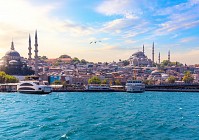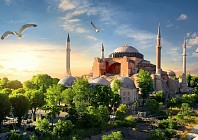To understand Istanbul’s hammams is to know the city. If their walls could talk, these great testaments to the Ottoman age would no doubt narrate countless tales of gossip and intrigue. None more so than Galatasaray Hammam, on Istanbul’s European side. Here, the terracotta walls would recount stories of how the foundations were laid in 1498 by Sultan Bayezid II, who wanted a preparatory school for children heading to the Topkapi Palace for their Ottoman education.
They’d speak of how, in the mid-19th century, the baths were rebranded as Galatasaray Lycée, a school for diplomats. Lastly the walls, with their rich marble borders, would whisper of how in the Swinging Sixties it became a magnet for detoxing celebrities, opening its doors for the first time to women bathers to keep in the spirit of the age.
In fact, the hammams can be viewed as microcosms of Turkish life throughout history. When the Turks lived as nomads in the Central Asian steppes, water was scarce and the Turkish tribes closely guarded it, considering the life source sacred. Later, when these tribes migrated to Anatolia and converted to Islam, they adopted the Islamic tenets of cleanliness and bathing. Cleanliness is, of course, next to godliness and it’s therefore not surprising that many hammams are attached to mosques.
During the Seljuk and Ottoman periods, Turkish baths combined the aesthetic aspects of the Eastern bath tradition with their complex water systems and the heating techniques of the multi-roomed Roman bathhouses. There were key differences between Roman baths and hammams. The open and closed areas of Roman baths tended to be larger than the Ottoman hammams and, unlike Roman baths, the outer walls of hammams were not at all intricately designed.
These bathhouses attracted all walks of life. Sultans would visit alongside humble workers, and everyone would go in with the same aim: to combine pleasure with a practical body scrub. Over time, the Turkish baths became a place to meet as well as a place to get clean. During Ottoman times they were some of the few venues where women could socialise — separate from men, of course.
Architecturally, most hammams follow the same plan. There is a marble podium — usually white marble from Turkey’s Marmara region — covered by a large central cupola, often punched with star-shape perforations to let light in, with rooms set off to the sides. There is a hot room where guests get steamed up and are massaged, then there is a warm room for washing and a cold room where post-treatment relaxation takes place. Treatments end in the camekan (lobby or lounge area) where there is normally a lot of talk over tea. Two sets of doors usually lead out onto the street, one for women and another for men. The bathhouse ritual is always the same — a bath, a soak and a soap massage.
A century or so ago there were around 2,500 working hammams in Istanbul but today only around one hundred remain. Many have been converted into shops and cafés. Of Istanbul’s surviving public baths, quite a few are little more than tourist attractions, however there are some that really ought to be visited for their historical importance.
The Çemberlitaş Hamami (Vezirhan Caddesi 8), dating back to 1584 and designed by the great Ottoman architect Sinan, is among the most beautiful in the city. Commissioned by Nurbanu Sultan, wife of Sultan Selim II, the hammam features two bath chambers each commanded by a marble heat platform, over which a striking cupola with glass apertures dominates. Visitors can bathe between 6.00am to midnight and people come from far and wide to experience it. Not far away, the 450-year-old Süleymaniye Hamam (Mimar Sinan Caddesi 20), also designed by Sinan, is also a contender for Istanbul’s most impressive hammam, with its huge cupola and location next to the Süleymaniye Mosque, close to the Grand Bazaar. After being closed for 80 years, it was restored and reopened in 2004. Today, it draws many visitors for its splendid entrance hall and marble work.
Lastly, the Kılıç Ali Paşa Hamami, another of Sinan’s designs, dates back to the 1580s and was reopened in 2012 after considerable restoration. The decor is minimalist and by far the most luxurious option of the antique hammams in the city. The 17-metre high cupola is worth the visit alone.
With the ongoing building boom in Istanbul, many new five-star hotels now offer classically designed hammams within their spa complexes. Today’s hammams are much gentler than the original Ottoman ones. Treatments are less forceful and are more along the lines of traditional massage movements rather than the thumping, hitting method that traditional therapists once used. The heat is less intense and the steam not as stifling, but the biggest difference of all is the fact that nowadays guests are regularly given the option to choose the sex of their therapist and can even opt for couples treatments. The beneficial effects, however, remain the same. The mix of sauna and massage is the ultimate tonic for the skin. Nothing beats warm temperature for helping essential oils soak into the skin and only through massage can they penetrate further. It’s a tried-and-tested method and it works.
If it is a sophisticated hammam experience that your body needs then the spa at the Four Seasons Hotel Istanbul at the Bosphorus is a good choice, with several different treatments available in a traditional marble hammam setting. There is the Traditional Ultra Luxury hammam which, along with the usual hammam experience, also includes a top-to-toe treat combining a soothing foot massage with a nourishing hair treatment and body mask. Then there is the Epicurean Hammam, an unusual take on a traditional treatment and one that is literally good enough to eat. Bathers are cooled down with an olive oil ice-cream popsicle or two while being swaddled in a strained yogurt and rosewater wrap.
Not far away, the new Shangri-La Bosphorus, located in Besiktas right along the banks of the Bosphorus (the strait that cuts the historic centre of Istanbul in two), has to be at the top of any serious spa-goer’s list. The hotel is home to Europe’s first CHI The Spa and even seasoned spa visitors can’t help but be impressed. As with all the best spas, it’s not the decor — although here, it is very smart indeed — it is the therapists who can make a good spa a great one. My Thai therapist Dolrudee was effective, intuitive and graceful, and her work could be felt for days afterwards. I could not rate her highly enough and would travel back to Istanbul just to have another CHI Balance massage with her.
The location, right by the opulent Dolmabahçe Palace, is quiet and the views onto the Bosphorus are unmatched, as you literally cannot be closer to the water. Add to this the staggering craftsmanship in marble decor and exceptional service throughout, and this hotel makes an incredible addition to Istanbul’s luxury hotel scene. The air of refined elegance means that it is hard to imagine that the hotel stands on the site of a 1920s tobacco factory.
One of Istanbul’s more established hotels, The Ritz-Carlton, Istanbul, also boasting fantastic views of the Bosphorus, has an award-winning, five-star spa on its premises. As well as an authentic Turkish hammam, you can book in for a unique spa experience here, known as the ‘Open Air Spa’. Two treatment rooms are located on the roof beside the swimming pool, where you can unwind with a treatment from a full wellness program, massage therapies, facials and body treatments.
These luxurious five-star hotel spas are the new-age places in Istanbul to relax and enjoy a hammam; they are private, modern and staffed by fully trained therapists who use organic products. They provide an interesting contrast to Istanbul’s historic and still thriving hammams, which are physical windows into the city’s Ottoman past — a glimpse of a romantic, bygone era.
THE GOLDEN BOOK
Four Seasons Hotel Istanbul at the Bosphorus
Tel: +90 212 381 4000
www.fourseasons.com
Shangri-La Bosphorus Istanbul
Tel: +90 212 275 8888
www.shangri-la.com/istanbul
The Ritz-Carlton, Istanbul
Tel: +90 212 334 4444
www.ritzcarlton.com
Park Hyatt Istanbul
Tel: +90 212 315 1234
www.istanbul.park.hyatt.com
Pera Palace Hotel Jumeirah
Tel: +90 212 377 4000
www.jumeirah.com
Kılıç Ali Paşa Hamami
Tel: +90 212 393 8010
kilicalipasahamami.com













